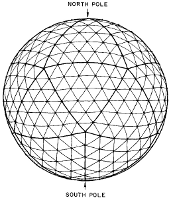
CHIMERE
CHIMERE multi-scale model is primarily designed to produce daily forecasts of ozone, aerosols and other pollutants and make long-term simulations (entire seasons or years) for emission control scenarios.
The CHIMERE multi-scale model is primarily designed to produce daily forecasts of ozone, aerosols and other pollutants and make long-term simulations (entire seasons or years) for emission control scenarios. CHIMERE runs over a range of spatial scale from the regional scale (several thousand kilometers) to the urban scale (100-200 Km) with resolutions from 1-2 Km to 100 Km. On this server, documentation and source codes are proposed for the complete multi-scale model. CHIMERE proposes many different options for simulations which make it also a powerful research tool for testing parameterizations, hypotheses. CHIMERE is a parallel model that has been tested on machines ranging from desktop PCs running the GNU/Linux operating system, to massively parallel supercomputers (HPCD at ECMWF).

DYNAMICO
DYNAMICO project develops a new dynamical core for LMDZ, the atmospheric general circulation model (GCM) part of IPSL-CM Earth System Model.
The DYNAMICO project develops a new dynamical core for LMDZ, the atmospheric general circulation model (GCM) part of IPSL-CM Earth System Model.
LMDZ6, the current version of LMDZ, has a shallow-atmosphere, hydrostatic dynamical core. It is based on a latitude-longitude C-grid, a hybrid pressure-based terrain-following vertical coordinate, second-order enstrophy-conserving finite-difference discretization and positive-definite advection. Grid refinement is implemented as a continuous zoom via smooth grid stretching. An extensive package of physical paramererizations is coupled to the dynamical core. IPSL-CM is currently used to produce AR5 simulations. LMDZ is also at the heart of GCMs of planetary atmospheres (Mars, Venus and Titan).
It is well-known that the latitude-longitude coordinates have a strong singularity at the poles which is undesirable in terms of both numerical stability and computational efficiency. Regular tesselations of the sphere such as a recursively subdivided icosahedron provide an almost-uniform grid and a path to highly parallel computations based on domain decomposition. LMD’s logo is itself an icosahedron, evoking the pioneering work of Robert Sadourny on the use of icosahedral grids for solving the equations of atmospheric motion.
The primary goal of DYNAMICO is to re-formulate in LMDZ the horizontal advection and dynamics on a icosahedral grid, while preserving or improving their qualities with respect to accuracy, conservation laws and wave dispersion. In turn, a new grid refinement strategy is required. A broader goal is to revisit all fundamental features of the dynamical core, especially the shallow-atmosphere approximation, the vertical coordinate and the coupling with physics. Efficient implementation on present and future supercomputing architectures is also a key issue addressed by DYNAMICO.
DYNAMICO is funded by the Indo-French Centre for the Promotion of Advanced Research. It is currently seeking funding from the IPSL and the G8 Research Councils Initiative on Multilateral Research Funding.

LMDZ
LMDZ is an atmospheric general circulation model developed since the 1970s at the Laboratoire de Météorologie Dynamique, with variations giving terrestrial and planetary versions (Mars, Titan, Venus, giant planets, exo-planets). (LMD is the acronym of the laboratory, the “Z” of LMDZ is for “zoom”).
LMDZ is an atmospheric general circulation model developed since the 1970s at Laboratoire de Météorologie Dynamique, with variations giving terrestrial and planetary versions (Mars, Titan, Venus, giant planets, exo-planets). (LMD is the acronym of the laboratory, the “Z” of LMDZ is for “zoom”).
In its terrestrial version, LMDZ is the atmospheric component of the “Integrated Climate Model” of the IPSL, whose development is coordinated by the “modeling pole” and which is involved in the huge international research effort on future climate evolution.
On the planetary side, versions of LMDZ have been developed largely in connection with the space exploration of the solar system, and more recently with the search for extra-solar planets.
LMDZ is first and foremost a research tool. A recurring concern in the development of LMDZ is to privilege lightness and flexibility.
A constant work is carried out on the evaluation of the climatic performances of the model. LMDZ also allows the simulation of satellite observations (RTTOV, ISCCP, CALIPSO …) and it can be used in semi-operational mode: real-time or non-real-time guided zoomed versions, pollutant transport and retro-transport, etc.
Since 2019, LMDZ is labeled INSU national “Community Code” service (you will find here a description of the INSU labeled services).

ORCHIDEE
ORCHIDEE (Organising Carbon and Hydrology In Dynamic Ecosystems) – the land surface model of the Institut Pierre Simon Laplace (IPSL) earth system model
The ORCHIDEE model –
- represents the state of the art in global land surface modelling. It is the intent of the development team to remain at the forefront of this exciting field.
- can be run as part of the IPSL Earth System Model (ESM), but may also be deployed as a stand alone terrestrial biosphere model. The latest version, which can be run in a coupled set-up, may be obtained by submitting a request through our contact page. When run as a stand alone model, thematic versions (or branches) with increased functionality in specific areas are also available.
- is widely used by researchers in France, China, Belgium, Germany and the USA. It has resulted in a number of publications in high-impact journals such as Nature, Science, PNAS and Nature Geoscience.
- is well established in the international research community. Its simulations have contributed to the Nobel prize winning efforts of the IPCC, as well as to numerous landmark projects such as the Global Carbon Project, LUCID and iLambs, CMIP3 and CMIP4.
The ORCHIDEE team is continuously enhancing the scientific capacity of the model by means of new developments. At the same time, a persistent effort is maintained to guarantee the quality of the model code and its simulations. If ORCHIDEE can contribute to your research, or your skills and expertise could strengthen our team, please don’t hesitate to contact us to discuss future collaboration.

Regional climate model
RegIPSL regional climate model of IPSL is a regional Earth system model coupling the following components : WRF, ORCHIDEE, NEMO and CHIMERE. The coupling between these components has been achieved with the OASIS3-mct coupler.
The RegIPSL regional climate model of IPSL is a regional Earth system model coupling the following components : WRF, ORCHIDEE, NEMO and CHIMERE. The coupling between these components has been achieved with the OASIS3-mct coupler.
The main region of application for this model is the Mediterranean but it will also be used for other regions like South America and South East Asia. Some standard configurations are provided with the code to facilitate the learning process.
Currently, the system deployed on the Med-Cordex area couples together :
- ATM : WRF 3.7.1 at 20 km resolution
- OCE : NEMO 3.6 (Med condiguration) at 1/12° resolution
- SRF : ORCHIDEE trunk on the same grid as WRF
In the future, WRF will be replaced by the Limited Area version of DYNAMICO with physics suitable for km resolution.
Up to now, the system is developped on IDRIS center. (should also work on TGCC and IPSL mesocenter).
for further details see : https://sourcesup.renater.fr/wiki/morcemed/


